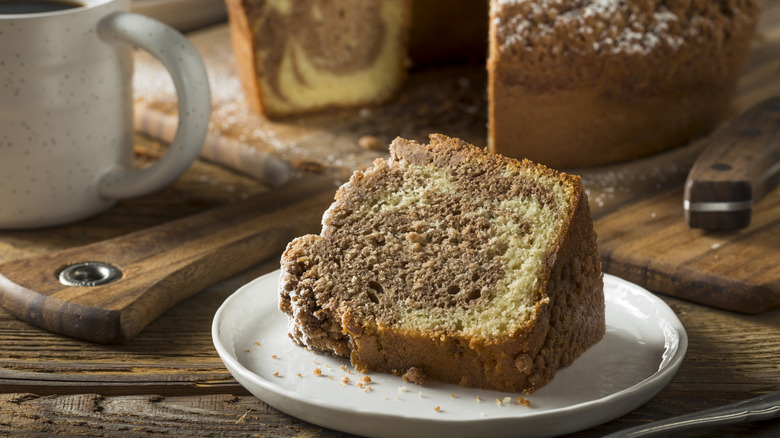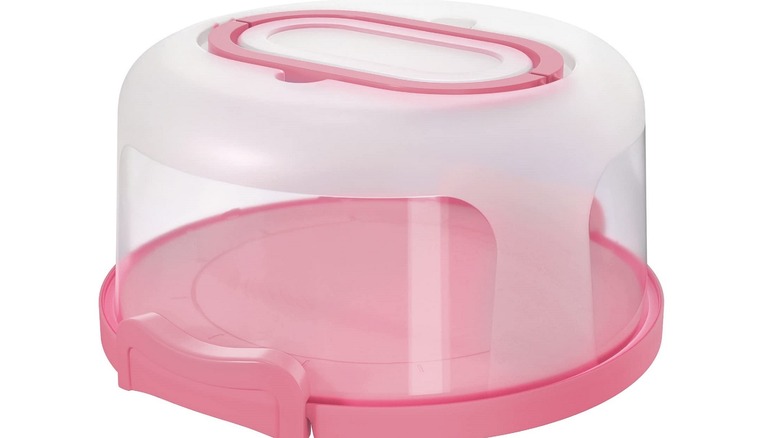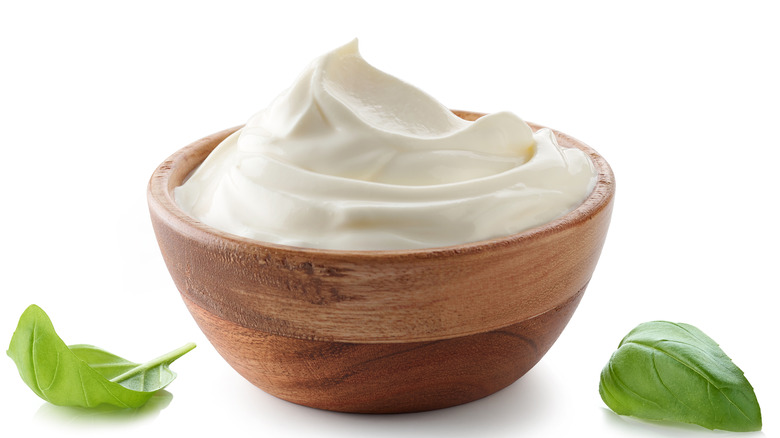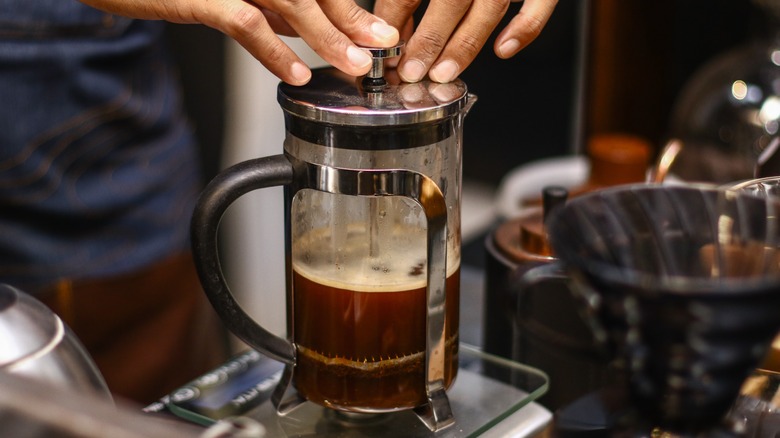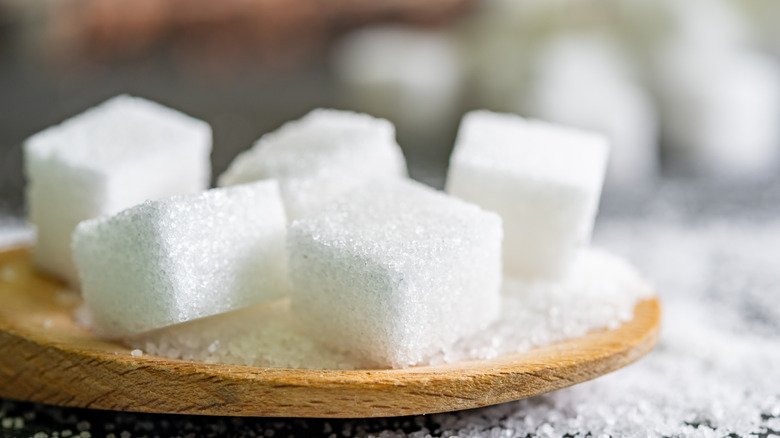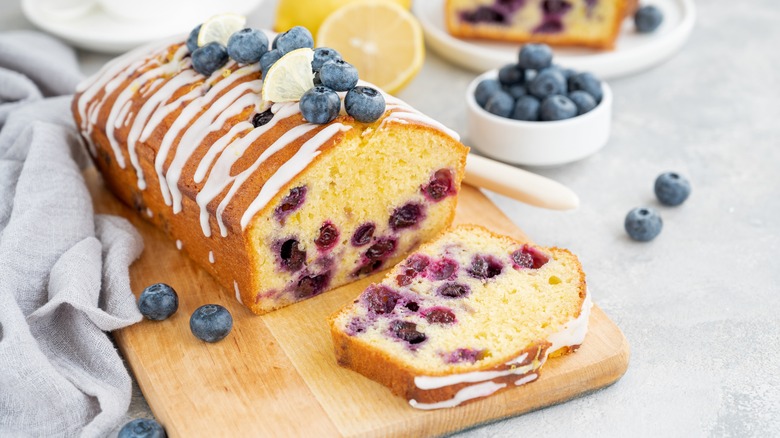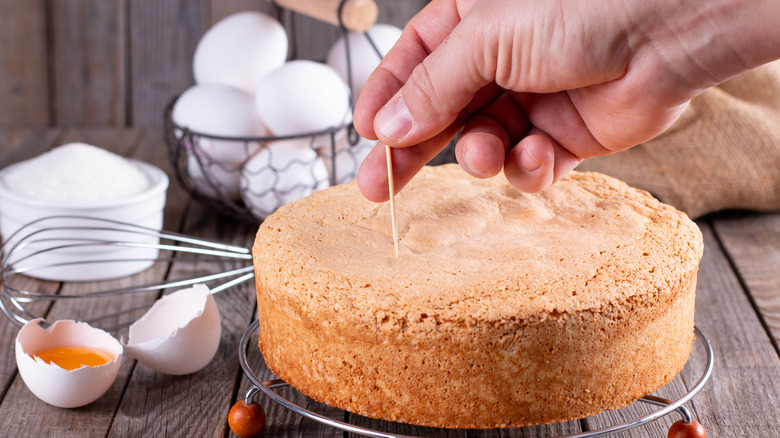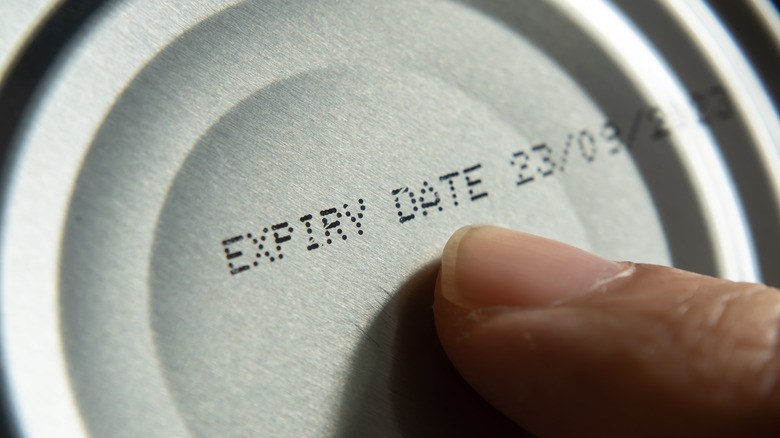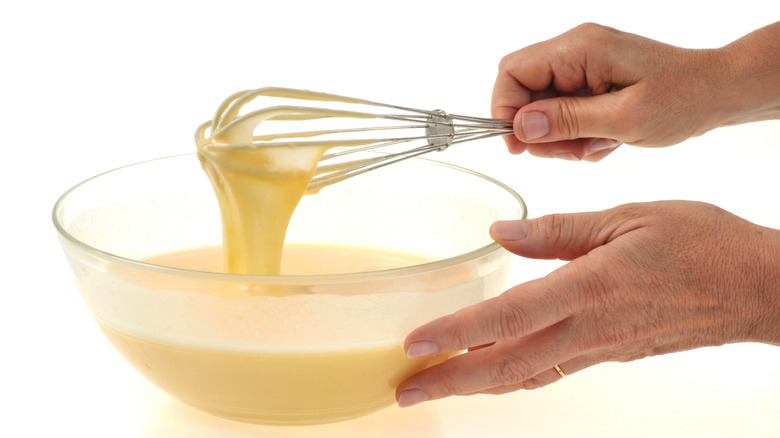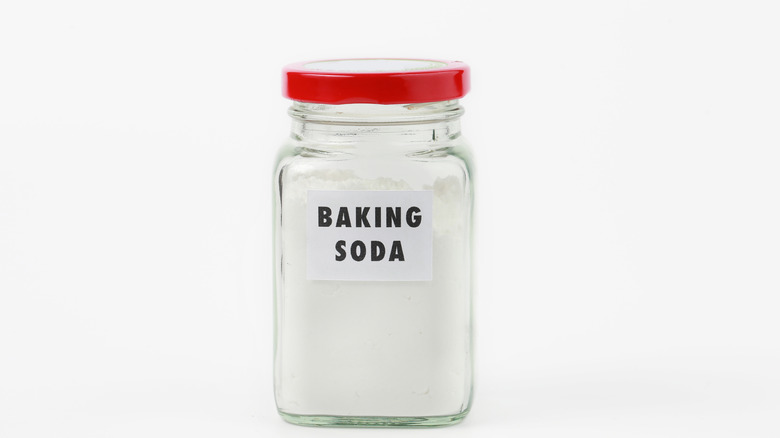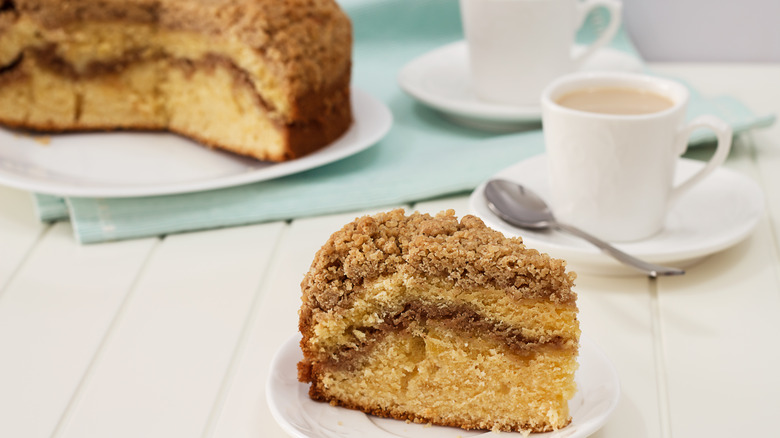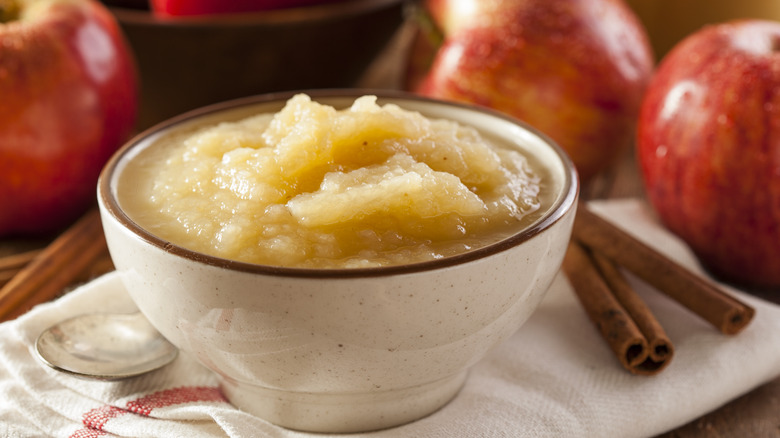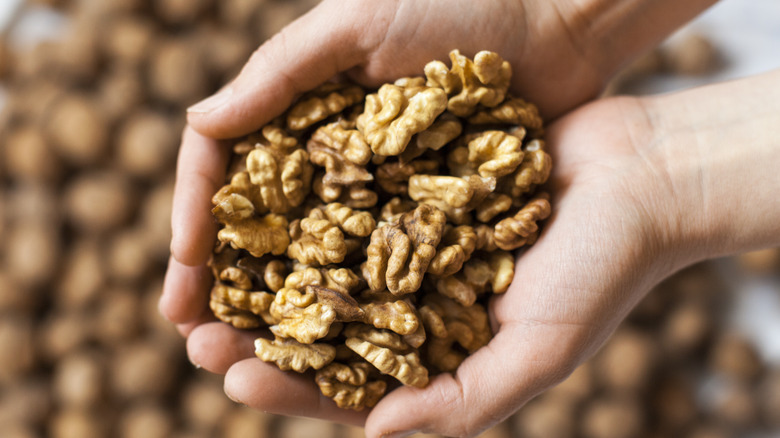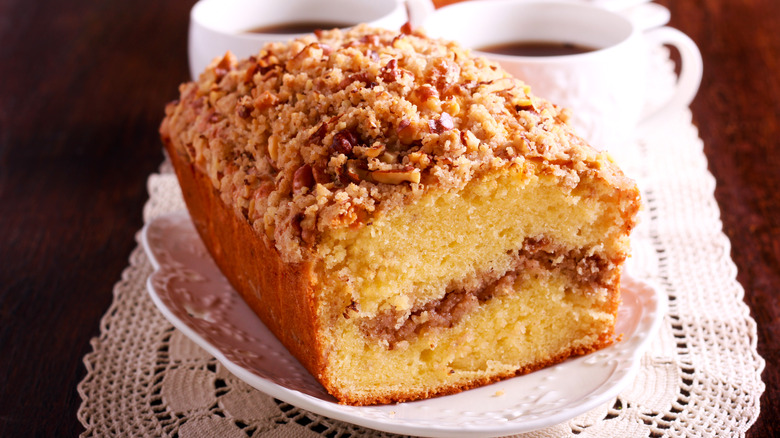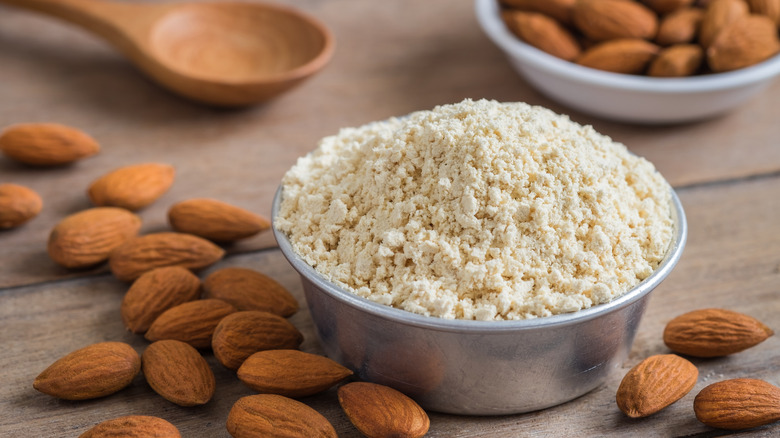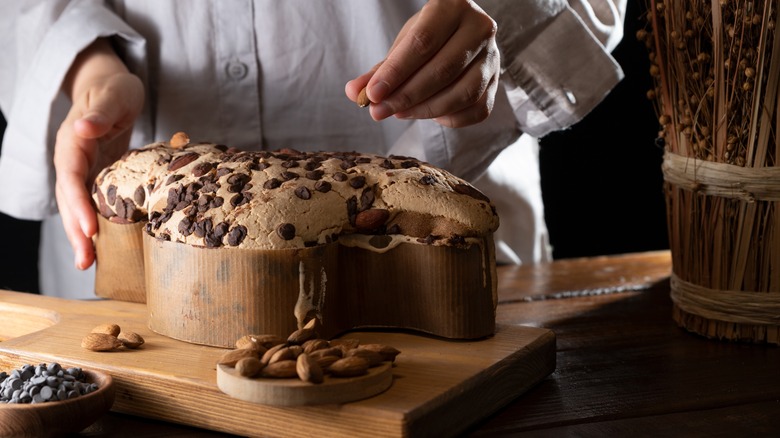15 Tips You Need When Making Coffee Cake
Whether you're enjoying a slice while sipping a cup of joe or simply indulging in a little after-work treat, coffee cake is a fantastic pastry choice. When baked properly, it has a decadent, spongy consistency that is moist on the inside with a crumbly exterior. The problem is when dealing with a cake that absolutely needs to maintain its moisture level, even minor tweaks or errors during the baking process can result in a dry, lifeless mess. Even dunking the desert of a dessert into your coffee won't resuscitate it back to life. And is there anything worse than planning a special gathering inside your home, or preparing a dish to share with others, and it comes out dull, dry, and flaking apart?
Maybe you've had that problem in the past, or maybe it's your first go-round and you want to make sure you knock your coffee cake out of the park. Here are several tips you need to take advantage of when making your next coffee cake.
1. Invest in an airtight container
When dealing with a moisture-laden baked good, your top priority needs to be maintaining its moisture level. This means as soon as it's out of the oven and you're slicing into it, the cake turns into a ticking time bomb of dryness. In order to prevent it from becoming an arid, lifeless mess, you need to set the cake inside an airtight container.
If you are baking your coffee cake ahead of time, you should also secure your baked good into an airtight container. Treat your cake like a great valuable that needs to be under protective glass at all times. Because if you don't, the cake will be robbed of its moisture, and that theft will leave you (and your guests!) wishing for that once-moist piece of cake.
Thankfully, you can purchase containers made specifically for storing cakes, so you don't have to mash it down to the size of a casserole dish. Nobody likes baking a cake and then being forced to slash away at it so it fits into whatever air-tight Tupperware container is available. It's a minor investment, but it will make a major difference.
2. Add sour cream to your coffee cake
Sometimes baking a coffee cake can feel like building a house of cards. Any wrong move and the entire thing turns into a crumbled disaster on the table. Thankfully, unlike stacking playing cards, there are a few moisture-adding tricks you can, and should, take advantage of. Of these tricks is adding sour cream to your coffee cake.
Sour cream is an incredibly durable ingredient for baked goods. Thanks to its high level of fat content, it is able to not only thicken the batter of your coffee cape, but it will help boost its moisture levels as well. But we understand if you read "sour cream" and immediately assumed it would ruin the taste of your cake. After all, your recipe likely doesn't call for sour cream, so naturally it would dramatically alter the flavor, right? Don't worry — the taste of the sour cream won't shift the outcome of your cake dramatically, although if you're concerned, it's worth trying it out on a "dry" run. You might end up discovering the subtle flavor change actually improves the final product.
3. Consider replacing some of the liquid with coffee
Coffee cake earned its name because it is commonly served when drinking coffee. But perhaps you want to add some real coffee taste to the cake itself. There are a number of ways to do this, but one of the most direct methods for instantly folding in delicious coffee flavor is to replace some of the liquid in your recipe with actual brewed coffee.
The quality of your coffee will be a factor here. While you're more than welcome to try some Folgers or Nescafe, we would instead recommend using a coffee you just ground and brewed yourself. There's just a lively, fresh taste that comes with coffee that's been freshly ground and brewed.
With all of this in mind, it is especially important not to replace milk in the recipe. This is because your cake needs the fat content of dairy. Instead, swap out some of the water your coffee cake recipe requires. It is a little flavor enhancement that might take your cake to the next level.
4. Don't swap out the sugar
Perhaps you are looking for ways to cut out calories from your diet, and eliminating sugar is one idea you are considering. While it is possible to experiment with removing sugar from other baked goods, you will want to refrain from removing sugar from your coffee cake. Why? Sugar helps a cake retain its moisture. Coffee cakes, more than most other cakes, rely on moisture, so cutting out the sugar will greatly increase the chance of baking a dried cake.
Swapping sugar with alternative sweeteners or reducing the amount of sugar used in baked goods like cookies can work, as you're not dealing with a rising cake, and moisture levels are of minor importance. So, if you're looking to cut sugar out of your baked goods, do so with cookies. Don't do it with cakes —particularly coffee cake. It's one of those baked goods that absolutely requires fatty milk and real sugar.
5. Ice your cake
Don't leave that poor coffee cake naked. Ice it up! Icing will not only bring added sweetness and an additional texture to the cake, but it also helps lock in moisture. The icing acts as a barrier between the exterior and interior of the cake. This is especially important if you may have leftovers.
Icing is different from frosting. Frosting is a thicker addition that can bring a high level of sweetness, but if you're not careful, frosting can quickly devolve your cake into tasting like something bought out of the big chain grocery store's bakery. Chances are, if you're making a coffee cake, that's not the taste you're going for. Icing, on the other hand, is a thinner topping. It's a nice sugary glaze that isn't as dense but still brings a nice lift of sugar, all without bogging the taste down with too much unnecessary sweetness. Naturally, you should do what works best for your taste buds, but in our opinion, icing is the way to go.
6. Know when your cake is done
This is one of the biggest issues with baking a coffee cake (and, as you might guess, most cakes). You want a level of moisture that isn't dense, and at the same time isn't dry, but you also want to make sure your cake has baked all the way through. Wait too long in the oven and you have a dried-out, crumbly mess. Pull it out too soon and it's just wet batter that drops to the bottom of your stomach like a sugary brick.
First of all, it is always a good idea to know exactly what temperature your oven is running at. The listed temp on the oven isn't always accurate (especially if it is a few years old). We always recommend having a stand-alone oven thermometer so you know the exact temperature and can make any fine-tune adjustments as necessary.
As for knowing when you're coffee cake is done, you want to gently press the center of the cake. If it is springy, that's a good start. Now, use a toothpick, insert it into the cake, then pull it out. If it comes out cleanly and there's nothing sticking to the toothpick, the cake is ready.
7. Check your expiration dates
When dealing with baked goods you're relying on a lot of things to go right. The cake batter needs to have been mixed adequately, but not over-mixed. The cake batter needs to rise, it needs to cook evenly, it needs to not overheat in certain places, and yet you can't always tell what is going on inside the cake as you peer through the tinted oven window. With so many variables, you need to take out any possible negative culprits.
Check the expiration dates on all your products, including the flour and baking soda. It is easy to overlook the expiration date of these ingredients, and yet one of the main reasons why a cake comes out dense is because the baking soda or baking powder is past its prime. Thankfully, flours, baking sodas, and baking powders will typically last for well over a year, so you have plenty of time to use up your purchase.
8. Don't overmix your coffee cake
If you didn't know you could overmix cake batter, you're not alone. Many people don't know it's possible to mix for too long. But what does mixing cake batter for too long do? It can heighten the gluten levels within the batter, which in turn will result in a tougher cake. And no, we don't mean a cake that can take a hit. We mean one that's not easy to chew.
Your coffee cake recipe will indicate what to look for when mixing your cake. Usually, you want to mix out large lumps of flour and other powders. However, it is generally okay if there are still some small bits within the mixture. If you find these little bits won't fully mix into an entirely smooth consistency, that is totally fine — leave them be. Attempting to go after the small clumps will increase the chance of overmixing your cake batter, which is far more devastating to the final product than leaving these little flour bits intact.
9. Baking powder to the rescue
Baking powder is the less-often-used cousin of baking soda, but hopefully you have both in your kitchen right now. Sure, baking soda is able to wash teeth, clean carpets, and disinfect stove tops, but baking powder is able to moisten up your cake. That's one superpower all bakers can rely upon, as sometimes it can feel like you're in an uphill battle to maintain a perfectly moist, decadent cake.
If you have attempted your coffee cake recipe in the past but it continually comes out on the drier side, it's time to turn to baking powder. Adding a little extra will help boost the moisture level of your cake. It doesn't take much baking powder to enhance the moisture level of your coffee cake, and it also won't alter the flavor. So, if turning to sour cream isn't something you want to try out, baking powder is a viable option.
10. Remember ways to fix a dry coffee cake
Did the unthinkable happen and your cake came out dry? Before you toss it in the trash and run out to the local bakery with plans of pulling their label off and presenting it as your own creation there is still hope for that not-so-moist coffee cake. Yes, there's probably no time (or energy) to try again, but you can still pump a bit of moisture back into the cake and distract consumers of your baked good with a little sleight of hand as well. After all, what's good for magic is good for baking.
Before you add the icing over the top of your coffee cake, you'll want to drizzle it with a simple syrup. The dry cake will absorb the syrup, drinking in moisture like a thirsty camel in a desert oasis. And, if your cake is sturdy enough to let you slide it horizontally, you can bisect the cake into two, then slather the middle with frosting before placing the top half back into position. This layer of frosting will help break up the dry taste and instead, replace it with some sugary goodness. Nothing distracts from baking blemishes like a dollop of sugar.
11. Add apple sauce
During the fall months when the weather begins to turn cooler and you're preparing a coffee cake for tailgates or to enjoy with friends as you watch the foliage out your window, there's just something about the taste of apples that makes everything in the world feel right. If you are making an apple cider coffee cake (or anything with apples, for that matter), we suggest adding applesauce to your batter. This will bring a hint of both apples and, likely, cinnamon, all while improving the overall moisture level of your cake.
Much like adding a fresh roast to your cake to enhance the flavor of a coffee, you can do something similar with applesauce. (And who's to say you can't do both at the same time? A baker can dream, can't they?) Best of all, with applesauce you have all kinds of flavor options nowadays. You can go with traditional applesauce, opt for extra cinnamon, or even use a tarter Granny Smith apple if this fits your personal flavor palette.
12. Go nuts with the toppings
The thing about straight-up coffee cake is that there isn't much to break up the texture. It's all soft and sugary. That's perfectly fine, and we love it that way, but if you want to knock your cake out of the park, you might want to bring in a textural highlight to the cake. Want to know why Snickers are so darn good? It's because of the peanuts. Some people might like the taste of peanuts, but really, it's that nice crunch that elevates the candy bar. You can Snicker up your coffee cake with your own introduction of nuts to the top. Peanuts might be a bit too simple for your elegant coffee cake, though. Instead, we suggest going with walnuts on your coffee cake, which is a more robust and earthy taste. You can even opt for classic almonds.
Of course, if you really wanted to go the Snickers route, you could just chop up some Snickers. We haven't tried it yet, but if you do and discover it is the greatest-tasting thing in the world since, well, Snickers, be sure to let us know.
13. Add crunch to your cake beyond nuts
There's more than one way to add crunch to your cake. If you're not a fan of nuts (or someone has a nut allergy), you'll want to look elsewhere to find ways to add that little extra textural crunch to your coffee cake. In fact, let's say you want to stick with a sweeter addition to the top of your cake, but you still want a fantastic crunch. One way to do this is to craft a sugary-sweet "crunch" topping.
We have a fantastic recipe for such a coffee cake, and the topping includes sugary, crunchy bits consisting of corn syrup, baking soda, sugar, and strong coffee. When allowed to harden, the small chunks will provide you with some exceptional crunch, all while offering both a sweet kick and a solid coffee punch. Basically, it becomes the best of both worlds. You don't even need to leave this as the only topping, either — you can add it over icing, frosting, or any other addition you might want to include with your cake.
14. Up the nutty flavor with almond flour
Interested in adding some nutty flavor to your coffee cake but you'd like to maintain the smooth, moist consistency, possibly without nuts or other crunchy add-ons? If so, one of the best ways to go about achieving this goal is to swap the kind of flour you use. Traditional flour works just fine, but we often love to experiment with our flours just to see what kind of alternative flavor we're able to discover. One of our favorite change-ups, at least in terms of a coffee cake, is taking advantage of almond flour.
Almond flour will give you the same basic rise-and-bake quality as regular flour for your coffee cake, but you'll add a distinct nutty taste. This can be a nice way to alter a current recipe you believe has gone flat, or one you want to experiment with and are not exactly sure what changes you should tweak.
15. There's no such thing as too much chocolate
Let's face it: There's no such thing as too much chocolate. There's a reason why you can purchase chocolate chocolate chocolate chip ice cream. And even now you might be looking at the last sentence and thinking to yourself, "What, only three kinds of chocolate? Amateurs." When you love chocolate, you want as much of it as you can get. That's why we say if you really want to add that decadent ingredient to your coffee cake, why not turn to cocoa?
There are so many ways you can add chocolate to your coffee cake if you want to enhance that chocolatey taste. Yes, chopping up bittersweet chocolate to pour over top of your cake works, as does melting down chocolate and drizzling layers over top of the icing is true heaven as well. Or, if you really want to work your way into the very batter of the cake, why not add some cocoa powder right into the batter while you're mixing? Chocolate is one of those ingredients that will almost never go bad on you. When it comes to adding chocolate to your cake, it is better to go big than go home.
